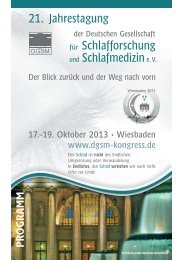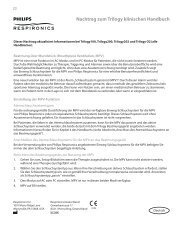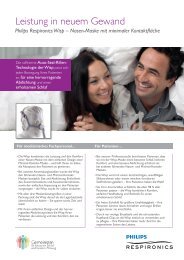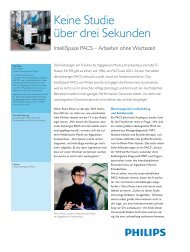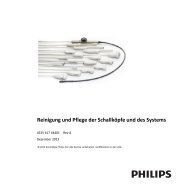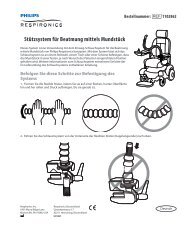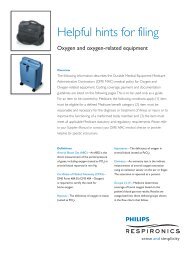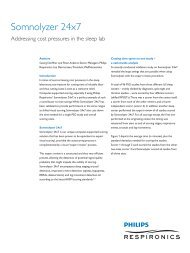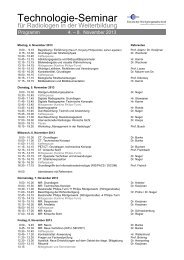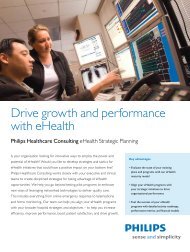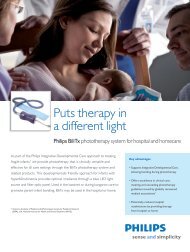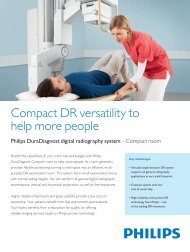IntelliVue MX600 and MX700 Patient Monitor - Philips Healthcare
IntelliVue MX600 and MX700 Patient Monitor - Philips Healthcare
IntelliVue MX600 and MX700 Patient Monitor - Philips Healthcare
Create successful ePaper yourself
Turn your PDF publications into a flip-book with our unique Google optimized e-Paper software.
• The Oxygen CardioRespiroGram (oxyCRG) screens provide a<br />
simultaneous presentation of up to three High-Resolution Trends:<br />
• beat-to-beat heart rate (btbHR)<br />
• an oxygenation measurement trend (SpO 2 or tcpO 2 )<br />
• compressed respiration rate.<br />
• This customized display gives clinicians a convenient overview of the<br />
neonatal patient’s most important vital signs, helping them to identify<br />
significant events.<br />
• Continuous oxyCRG recordings can be made at the bedside on the<br />
M1116B Recorder.<br />
•Dual SpO 2 measurement provides clinical support through<br />
comparison <strong>and</strong> trending of the pulse oximetry values from two<br />
distinct patient sites.<br />
• Trended values can also be viewed in the form of a histogram. The<br />
SpO 2 histograms can be trend histograms or real-time histograms<br />
with 1-second samples.<br />
• In Event Surveillance, in the NER group, you can run a Car Seat<br />
Assessment Record (CAR). This is a special period of event<br />
surveillance for neonates during a car seat test. During the CAR<br />
period, a real-time SpO 2 histogram is also generated with 1-second<br />
samples.<br />
<strong>IntelliVue</strong> Applications<br />
Clinical Decision Support<br />
Clinicians are continuously drawing mental images from their<br />
observations of patients’ vital signs. The <strong>IntelliVue</strong>’s clinical decision<br />
support applications offer this dynamic “minds eye view” directly on<br />
the monitoring screen display.<br />
ProtocolWatch<br />
ProtocolWatch allows clinicians to run clinical protocols that can<br />
monitor developments in the patient’s condition. The SSC Sepsis<br />
Protocol runs on the ProtocolWatch application <strong>and</strong> is used in<br />
screening for severe sepsis <strong>and</strong> monitoring its treatment.<br />
ST Map<br />
ST Map provides a graphical display that can help clinicians to recognize<br />
ST changes <strong>and</strong> their location in the heart more easily. ST Map collects<br />
ST values created from the frontal (limb leads) <strong>and</strong> horizontal (chest<br />
leads) plane into an integrated display. The maps are multi-axis<br />
portraits of the patient’s ST segments as measured with the ST/AR<br />
arrhythmia algorithm.<br />
Horizon Display<br />
Horizon trends provide clinicians with a graphical visualization tool that<br />
allows the end user to detect at a glance the patients’ current clinical<br />
status. By combining parameters together on the display, the clinician is<br />
assisted in their cognitive process of pattern recognition.<br />
Loops<br />
Up to six loops of each type can be stored <strong>and</strong> compared to detect<br />
respiratory changes more easily.<br />
Screen Display Flexibility<br />
Up to 20 different screens can be created per monitor, which means<br />
that the clinician has the ability to have a screen created to match a<br />
specific clinical scenario on which the data that matters is displayed.<br />
This streamlines the information that needs to be processed <strong>and</strong><br />
interpreted to make the right decision at the right time.<br />
Trends<br />
• A choice of four st<strong>and</strong>ard trend database configurations is provided,<br />
designed to suit specific application areas. <strong>Patient</strong> data from up to<br />
32 measurement numerics can be sampled every 12 seconds, one<br />
minute, or five minutes, <strong>and</strong> stored for a period ranging from four to<br />
48 hours.<br />
• Tabular Trends (Vital Signs) show data for up to 32 measurement<br />
numerics in tabular form. Tabular Trends can either be viewed in a<br />
separate window or permanently displayed on specially designed<br />
screens.<br />
– Each NBP measurement generates a column in the Vital Signs trend<br />
table. The values for the other measurements are added to provide<br />
a complete vital signs set for the NBP measurement time.<br />
•With Graphic Trends, up to three rows of measurement trends can<br />
be displayed in graphic form, each combining up to three<br />
measurements. Graphical Trends can either be viewed in a separate<br />
window or permanently displayed on specially designed screens.<br />
• Screen Trends permanently display trend data for periodic <strong>and</strong><br />
aperiodic parameters in graphical format on special screens. The<br />
displayed time period can be set to 30 min, 1 h, 2 h or 4 h.<br />
• High Resolution Trends allow the user to track fast-changing<br />
measurement trends with beat-to-beat resolution (four samples/<br />
second). The number of High Resolution Trends available for display<br />
depends on the wave option purchased.<br />
• Horizon Trends show the deviation from a stored baseline.<br />
• Trended values can be viewed in the form of a histogram. The SpO 2<br />
histograms can be Trend Histograms with 1-second samples.<br />
• Navigation arrows provide easy access to the stored trends. Trend<br />
data can be documented on a locally or remotely connected printer.<br />
•With Event Surveillance, changes in patients’ condition are<br />
automatically detected <strong>and</strong> an electronic record of data called an<br />
Episode is stored. The Episode can store:<br />
– 15 seconds of high-resolution wave trace,<br />
– four minutes of data sampled four times a second, or<br />
– 20 minutes of data sampled every 12 seconds.<br />
6




